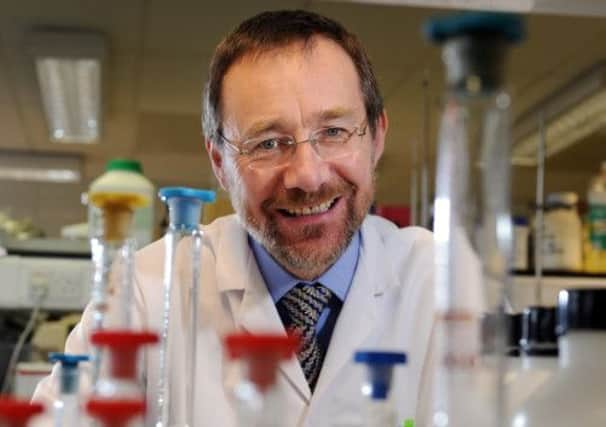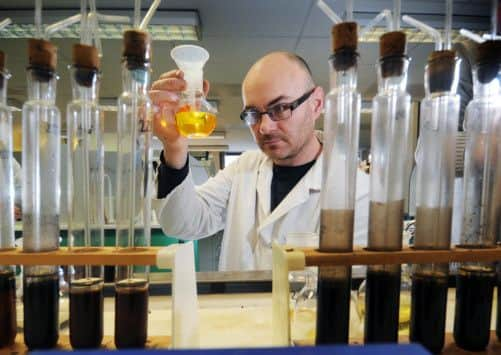‘Next time we may not spot dodgy food’


IN Bradford in 1858, 20 people died and 200 became seriously ill when lozenges were accidentally contaminated with arsenic rather than the normal adulterant of the time – Plaster of Paris.
This scandal, and other like it led, in 1860, to the first legislation to ban the adulteration of food. In 1872 Leeds appointed its first public analyst, and to this day by law every local authority must appoint at least one.
Advertisement
Hide AdAdvertisement
Hide AdFor 150 years these highly qualified and specialised chemists have been at the forefront of the battle to keep the public safe – from accidental contamination of food and drink, or the unscrupulous who deliberately adulterate foodstuffs for their own commercial ends.


Across the UK there are public analysts’ laboratories with teams of these scientists who test food, water, toys, cosmetics, animal feeds and much more to ensure that they measure up to legal standards.
Where food is concerned, they test samples sent to them by trading standards and environment health officers, carrying out analyses to check that food is safe and ensuring that it is what it says it is.
Every decade has seen its food scandals and scares, from the illegal dye Sudan I in spices to E.coli O157 bacteria in beef and the cataclysmic BSE in cows, which led to the mass slaughter of herds and dealt a massive body blow to public trust in the British beef industry.
Advertisement
Hide AdAdvertisement
Hide AdEach scare damages businesses (£300m was wiped off the Tesco market value almost overnight in the wake of last month’s horse meat in burgers scandal), and raises uncomfortable questions such as whether we take far too much for granted considering the complex and global nature of the food chain these days.
However good the methods and technology in farming or food production and the science around routine testing for disease or taint carried out by food and drink manufacturers and retailers themselves, there are always cases that get under the wire.
Public demand for cheaper food means some suppliers will always try to cut corners, say experts, and the monitoring and maintenance of food safety is under threat from budget cuts.
Walking into the labs of West Yorkshire Joint Services in Morley, Leeds, legions of test tubes, flasks, pipettes and Bunsen burners bring back visions of high school chemistry lessons.
Advertisement
Hide AdAdvertisement
Hide AdMen in white coats (there are women – they just don’t happen to be in evidence this afternoon) beaver away creating liquids in strange colours and a few interesting odours.
The recognisable low-tech kit is supplemented by more than a million of pounds worth of sophisticated equipment designed to analyse food and drink in every tiny detail.
Analyst Brian Bland is using acid followed by solvent as part of the process of measuring the fat content of various foods –comparing what’s stated on the packaging with what he finds when only the fat is left in the flask.
“Nothing is 100 per cent certain 100 per cent of the time,” says Brian. “Every now and again something slips through the net. That’s why we’re here.”
Advertisement
Hide AdAdvertisement
Hide AdA slightly more unexpected sight is a cluster of vodka bottles – some apparently well-known brands, others you may never of heard of.
Many are counterfeit or fake, containing diluted industrial alcohol. Dr Duncan Campbell, Public Analyst for West Yorkshire and head of the lab, says they may contain methanol, chloroform or xylene.
After graduating from Edinburgh and research in soil chemistry at Oxford and Reading universities, Dr Campbell worked in the public analyst lab in Hull, testing everything from teddy bears’ eyes to animal feed and the water quality of the Humber, as well as advising on pesticide policy.
In 1996 he moved to West Yorkshire for promotion to number two in the team, becoming head of the lab nine months later. He has a Mastership in Chemical Analysis – a high-level qualification awarded to only a few scientists in the UK each year. He is one of three such ‘masters’ in this lab.
Advertisement
Hide AdAdvertisement
Hide AdAmong the changes he has made is the conversion of the food testing process from one where the same scientist takes a sample through the whole battery of tests to a more streamlined system, meaning that chemists with complementary expertise handle different parts of the analysis.
The work is nothing if not varied. “One private client, a supermarket chain, sends all of its UK ‘foreign body’ analysis to us... where anything from a piece of glass or a little stone or an insect is found in a food item.” He pulls out a paper clip found to have been inserted into a loaf of bread after purchase – the subject of the many malicious claims made against the food indstry by a consumer.
European law requires tests to be carried out on imported goods from outside the EU. Some are held at ports while analysis is done and refused entry if they do not meet EU standards.
Consignments of plastic (nylon) cookware imported from China are routinely tested as they can release primary aromatice amines, carcinogens that can leech into food. Dr Campbell’s lab has not been involved in the ongoing ‘horseburger’ furore – although it does carry out DNA testing on whether, for example, cod sold at fish and chip shops is indeed cod and not Vietnamese catfish.
Advertisement
Hide AdAdvertisement
Hide AdAs one of the country’s foremost public analysts, Campbell has been called upon to comment on the rapidly developing story, which has so far pinpointed a source in Poland, which was not on supermarkets’ approved supplier list, for the horse meat found in burgers produced in Ireland and North Yorkshire.Attention is now turning to pork DNA found in Halal food supplied to prisons.
He warns that, despite the fact that supermarkets themselves are promising even more rigorous testing of their own – including in-house and very expensive DNA testing of meat products at Tesco – there could well be more food scares in future, if funding to public laboratories continues to be squeezed.
“So far as public analyst work goes, individual local authorities pay us for the work we do for them,” says Dr Campbell. “They have a sampling budget, which is generally less each year. They have to make difficult decisions about allocation of resources, and we come pretty far down the pecking order.
“I think that nationally local authorities now spend less than £5m each year on analysis carried out by public analysts for food law enforcement,” says Campbell. “For county councils, the number of food samples that are taken for analysis by public analysts has fallen by 47 per cent in the three years to March 2012.”
Advertisement
Hide AdAdvertisement
Hide AdThe number of public analyst laboratories has fallen, from 31 in 2000 to 17 now, while the number of public analysts has also reduced, from 61 to 32 over the same period. “This means that some mistakes that are being made will not be picked up.”
Horse meat in the food chain does not of itself pose a threat to human health (in many countries it’s a regular part of the diet), but the issue of horse meat in burgers has raised questions about food traceability and public trust.
Dr Campbell, who is also a recent past president of the Association of Public Analysts, says criticism has focused on the Food Standards Agency (set up after the BSE outbreak and ultimately responsible for food safety in the UK), but food inspection and analysis for enforcement purposes is carried out at a local authority level.
“Supermarket procedures are very good at controlling microbiology and there has never been a food poisoning incident linked to supermarket meat, but we’re less good at picking up horse meat type incidents because of the limited resources anyone is able to spend on testing (of food samples). Local authorities are doing their best, but they can’t do the job they need to do – just what’s possible with limited budgets.”
Advertisement
Hide AdAdvertisement
Hide AdWhile a single analysis of the content of water in milk is very cheap, analysis of the provenance of beef can cost hundreds of pounds, and some local authorities have as little as £6,000 a year to spend on food testing.
Could the public analysis of food be improved to use the available money more efficiently?
“The FSA is in a bad position through no fault of its own,” says Campbell. “It’s having to depend on unreliable mechanisms. A better model would be one which, while still allowing for local delivery, had at least some level of guaranteed direct funding.
“Each lab could have different areas of expertise, instead of what we currently have, which is a lack of co-operation and competition between labs for ever decreasing work.” This more strategic approach would be better at keeping the public safe, he says.
Advertisement
Hide AdAdvertisement
Hide Ad“We can’t test everything, so sampling is focused and risk-based, and as much as we can do with what’s available... Without fear of being too controversial, with fewer resources for inspection and analysis of food, it’s likely that more breaches of food legislation will go undiscovered.”
A history of food scares
BSE: COMMONLY called ‘mad cow disease’, this broke out globally in the late 1980s. The UK was the worst affected country, with more than 180,000 cattle infected and 4.4m slaughtered during the eradication program. So far 170 people have died from the human form of the disease (vCJD), mainly after consumption of BSE-infected beef.
E.coli: The worst recorded outbreak of E.coli was in Scotland in 1996, when more than 400 people were infected and 21 died after eating contaminated meat supplied by a butchers’s shop in Lanarkshire.
Sudan 1: In 2005, 600 processed foods were removed from shelves after contamination with the illegal carcinogen red food dye Sudan 1 was found.
Salmonella: In 2006, 56 people became ill and one pensioner died after eating Dairy Milk chocolate infected by salmonella. Cadbury traced the source to a leaking waste water pipe.